Right now this is just anything that comes to mind since I'm a complete noob at tumblr. I've been hearing about it for years but I never really felt like I had anything to say. Well all that has changed now and I figured I'd see what all the hype about tumlr is really about. Anyway don't take anything I say too seriously for now...I'll probably change it later when I become more comfortable with this website.
168 posts
Latest Posts by risingstarling - Page 3
Hey, you're awesome, thanks for existing, basically ^_^ Anyway, I wanted to know if you have any tips on how to write different personalities? My characters (all of them) always end up with the same default personality that I fall back on. Thanks!
Thanks for your question, darling! I think most of us have struggled with this – after all, we’re conditioned to one way of thinking, feeling, and acting for as long as we live. That doesn’t necessarily mean we write characters like ourselves, though. In fact, many of us have a “default character” that’s sassier than we are, sweeter than we are, or in some way different enough from us that we still feel like we’re writing a character.
The problem, then, isn’t that we can’t visualize a different personality than ours. On the whole, we can. What we’re missing are the small details that make it feel whole – otherwise, it’s like painting the same room six different colors and trying to pass it off as six different rooms. Different dominant traits can’t hide the fact that you’re working with one template!
So the question we’re left with: what are the traits we’re missing? And how can we change them to create a unique and whole personality?
Three Types of Character Traits
There are, as the title suggests, three major categories of personality traits as I see it: fundamental traits, acquired traits, and detrimental traits. A well-rounded character needs some of each to be three-dimensional and realistic.
Fundamental Traits
The fundamental traits of a person’s character are not as simple as interests and preferences; they are the very base of all decisions and desires. They are either learned in early life or developed over a long period of time, rooting deeply into the personality. A few examples of fundamental personality traits include:
Upbringing – The word choice here is conscious, as upbringing encompasses many different aspects of a person’s development. Consider who raised them, and with what morals and practices they were raised to adulthood. Consider their influences, both familial, social, and in media; consider the relationships that were normalized during their development, as well as the living conditions (financially, emotionally, environmentally, etc.). The people, places, emotions, and conflicts made common during a person’s developmental period are essential to their personality in adulthood. This is why psychologists often draw present-day problems back to a person’s childhood memories – because those formative years can subconsciously dictate so much of a person’s future!
Values – These may not coincide with the values a person is raised to hold, but upbringing certainly has an influence on this. A person’s values will direct the course of their life through every decision, large and small. You don’t need to outline everything your character believes is important – every moral and every law they agree/disagree with. But those values which stand above others will give your character purpose. A few of my favorite examples are: Jane from Jane the Virgin (whose initial storyline is heavily based on her religion and desire for a beautiful love story, as well as her childhood influences who inspired these values) and Han Solo from Star Wars (whose character development rested upon his values shifting from money and gratification to more honorable things).
Beliefs – Different from values, beliefs are a more general set of guidelines for how a person believes things are supposed to be. Beliefs can also be a source of great conflict, as a character tries to stay aligned with their beliefs despite other values or desires. These beliefs can be established systems, like religion or politics; they can also include more personal belief systems, like nihilism or veganism. A characters beliefs, like their values, can change over the course of the story – but even if a character is questioning one system of belief, like religion or pacifism, they should have other belief systems in place to govern some of their activity.
Reputation – A lot of human activity, whether consciously or not, is dictated by how others perceive them (or how they believe others perceive them). There are two types of reputation: personal and passing. For instance, a woman named Sally who gains a personal reputation of sleeping around will behave in reaction to this reputation – either sleeping around because everyone already expects it of her, or specifically not hooking up because she wants to shake this reputation, or developing a thicker skin to deal with the rumors until it passes. A man named Billy who, because of his tattoos, bears a passing reputation as an intimidating man will either try to soften his demeanor with strangers, own up to the image, or at least learn to expect judgment from strangers as a consequence.
Self-Image – Also relevant to a person’s behavior is the way they perceive themselves, which can often have little to do with their reputation. A lot of self-image is based on definitive moments or phases in the past. For instance: for several years after I started wearing contacts and cutting my hair, I still saw myself, in dreams at night, with long hair and glasses. One of my friends, similarly, could not seem to notice when boys would flirt with her during sophomore year – because she still saw herself as an awkward middle schooler with braces, and not as the charming cheerleader with the great smile.Inversely, self-image can be inflated, causing character to behave as though they are funnier, smarter, or more prepared than they truly are (see: the rest of my sophomore acquaintances). This can be an overlooked character flaw opportunity – or flawportunity…
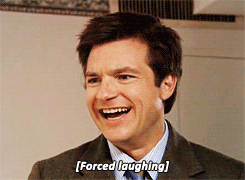
Acquired Traits
Now we move on to the acquired traits of personality, which are the ones you’re more likely to find on a character sheet or a list of “10 Questions for Character Development”, alongside a million other things like their zodiac sign and their spirit animal. But the traits I’m about to outline are a little more relevant to a character’s behavior, and more importantly, how to make this behavior unique from other characters’ behavior. The following traits will be learned by your characters throughout their life (and their story), and are more likely to shift and grow with time:
Interests – I know, I had to reach deep down into my soul to think of this one. But it’s true! Interests, both in childhood/adolescence and in adulthood, are an important part of a character’s personality and lifestyle. Childhood interests both reveal something about the character (for instance: my nephew loves trains, Legos, and building, suggesting a future interest in construction or engineering) and create values that can last for a lifetime. Current interests affect career choice, social circles, and daily activity for everyone. Forgotten or rejected interests can be the source of pet peeves, fears, or bad memories. There’s a reason I’ll never play with Polly Pockets again, and it 100% has to do with bloody fingertips and a purse that wouldn’t open.
Sense of Humor – This can be a little hard to define, understandably. If you were to ask me what my sense of humor is, I’d probably start with a few stupid memes, pass by Drake & Josh on the way, and somehow wind up telling you bad puns or quoting Chelsea Peretti’s standup comedy. A person’s sense of humor can be complex and contradictory! Sometimes we just laugh at stuff because someone said it in a funny way. But anyway, to help you boil this down to something useful: take a look at a few kinds of comedy and relate it to your character’s maturity level. Do they laugh when someone lets out a toot? Are they the kind of person to mutter, “That’s what she said,” or simply try not to laugh when something sounds dirty? Can puns make them crack a smile? Do they like political humor? Do cat videos kill them? Is their humor particularly dark? Can the mere sound of someone else laughing make them laugh? Figure out where your character’s sense of humor is, and you’ll feel closer to them already.
Pet Peeves – For every interest a person may have, and everything that makes them laugh, there’s something else that can piss them off, large- or small-scale. Are they finnicky about their living space and neatness? Do they require a lot of privacy? Do certain sounds or behaviors drive them crazy? What qualities are intolerable in a romantic interest for them? What kind of comments or beliefs make them roll their eyes? If you need help, just try imagining their worst enemy – someone whose every word or action elicits the best eye-rolls and sarcastic remarks and even a middle finger or two – and ask yourself, what about this person makes them that mortal enemy? What behaviors or standards make them despicable to your character? That’s all it takes.
Skills – Everybody has them, and they’re not just something we’re born with. Skills can be natural talent, sure, but they’re also cultivated from time, values, and interests. What is your character okay at? What are they good at? What are they fantastic at? Maybe they can cook. Maybe they have a beautiful eye for colors. Maybe they have an inherent sense of right and wrong that others admire. Maybe they’re super-athletic or incredibly patient or sharp as a tack or sweet as a cupcake. Maybe they know how to juggle, or maybe they’re secretly the most likely of all their friends to survive a zombie apocalypse. Where do they shine? What would make someone look at them and think, “Wow, I wish I were them right now”?
Desires – A good way to “separate” one character from the next is to define what it is they want, and then use every other detail to dictate how they pursue that goal. Every real person has a desire, whether they’ve defined it or not – whether it’s something huge, like fame or a family of five with triplet girls and a beach house on an island, or something small, like good grades for the semester. These desires can cause a person to revise their values or forsake their morals; and these desires can conflict with other people’s desires, influencing how people interact with each other. Remember that every character is living their own story, even if it’s not the story you’re telling.
Communication Style – A majorly overlooked character trait in pop fiction is unique communication styles. Having every character feel comfortable arguing, or bursting out with the words, “I love you,” is unrealistic. Having every character feel paralyzed at the idea of confronting a bully or being honest to their spouse is also unrealistic. There should be a healthy mix of communicators in a group of characters. Some people are too softspoken to mouth off at their racist lab partner. Some people wouldn’t see their girlfriend kissing another guy and just walk away without saying something. Some people just don’t react to conflict by raising their voice; some people enjoy sharing their opinions or giving the correct answer in class. Boldness, social skills, and emotional health all have a part to play in how people communicate their thoughts – so keep this in mind to create a more realistic, consistent character.
Emotional Expression – Along the same lines but not the same, emotional expression is more focal on feelings than thoughts. If you’ve ever heard of the fight-or-flight response, the different types of anger, the stages of grief, or the five love languages, then you’re aware of different “classifications” of emotional expression and management. Read up on some of those things, and think about how your character handles emotions like happiness, sadness, fear, anger, loneliness, paranoia, and so forth.
Detrimental Traits
While acquired traits are certainly more enjoyable to brainstorm during the creation process, detrimental traits are as important – or even more important – to the character’s wholeness as well as their role in the story. Not only do these negative or limiting traits make your character realistic, relatable, and conflicted – they create a need for other characters and their strengths to move the plot forward. A few examples of detrimental traits include:
Flaws – Character flaws are probably the first thing that came to your mind while reading this, but they’re the essence of the category. Flaws in a character’s personality, morality, or behavior can be a source of character development; they set an individual on their own path and provide a unique motivation for them. Having Character A struggle with sobriety while Character B learns to be a more patient mother can do a lot to separate their stories and personalities from each other. Even if certain flaws don’t reach a point of growth, they create a third aspect to personality and force us, as writers, to be more creative with how our characters get from Point A to Point B, and what they screw up along the way.
Fears – Everyone has fears, whether we’re conscious of them or not – and I’m not talking about phobias or “things that give you shivers”. Just like everyone has a primary motivation throughout life (romance, family, success, meaning, peace of mind, etc.), everyone has a fear behind that motivation (loneliness, failure, emptiness, anxiety). We all have something we don’t want to happen – places we never want to be and things we never want to do. We’ve all been in situations that mildly bothered others but wildly affected us at the same time. For me, it’s a lack of autonomy, or in any way being forced to do something or be somewhere against my will.What does this mean for me? It means that when other people have nightmares about being chased by an axe murderer, I have nightmares about being kidnapped and locked up. It means that I’m continually aware of my “escape plan” if something goes wrong in my living situation, and I’m hypersensitive to someone telling me, “You have to do this.” It means I struggle to follow rules and usually don’t get along with authority figures because I have to assert my independence to them. It’s irrational and continual and doesn’t just affect me in one situation; it subconsciously directs my steps if I let it. That’s how real, guttural fears work. Phobias are only skin deep, and they don’t make you feel any closer to the character.
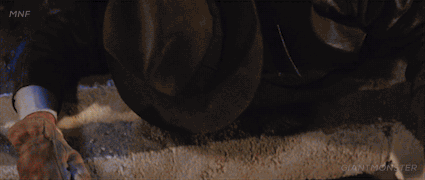
Secrets – Even goody two-shoes Amber from the swim team, with her blonde blonde hair and her good good grades, has a secret. Everybody does, even if it’s not a purposeful, “I have a deep, dark secret,” sort of secret. We have things we don’t tell people, just because they’re embarrassing, or painful, or too deep to get into, or they don’t paint us in a good light. While the secrets themselves tell a lot about a person, so do the reasons a person keeps a secret. Hiding something out of shame suggests a person is prideful, or critical of themselves, or holds themselves to a higher standard than they hold others. Hiding something painful suggests that the person struggles to handle sadness or regret, or that they feel uncomfortable showing raw emotion in front of loved ones. And so on and so forth.
Conflict – Whether internal, interpersonal, legal, moral, societal, or what have you, conflict will limit your character’s actions at every turn. A story is nothing without conflict driving the plot in different directions and causing your character to rethink both their plans and their lifestyle. Without Katniss’s moral conflict over killing other tributes, The Hunger Games would be the story of a girl who entered an arena, killed a lot of people, and lived the rest of her life rich and comfortable. If Luke Skywalker didn’t have interpersonal conflict with Darth Vader, Star Wars would be the war-story of a guy who joined a rebellion and then… yeah.
Health – Physical, mental, and emotional health is a huge limiting factor for characters that often goes untouched, but it’s valuable nonetheless. Not everyone has a clean bill of health and can jump off trains without pulling a muscle, go through a traumatic life experience without any hint of depression or anxiety, or watch a loved one die in gunfire and shove right on without emotional repercussions. Consider creating a character who’s not perfect – who isn’t perfectly in-shape or abled, or neurotypical or stable day-to-day, or completely clean and clear of residual heartache, unhealthy relationships, or bad emotional habits. Don’t define them by these traits, of course – but don’t feel that you can’t write a character with health issues without writing a “sick character.”
So this post got ridiculously long, but I hope it works as a reference for you when creating unique characters. Remember that you don’t need to outline all of this information to create an individual, realistic character. These are just some relevant ideas to get you started! It’s up to you, as the writer, to decide what’s necessary and what’s excessive for your creative process.
Still, I hope a majority of this is helpful to you! If you have any more questions, be sure to send them in and we’ll get back to you :) Good luck!
- Mod Joanna ♥️
If you need advice on general writing or fanfiction, you should maybe ask us!
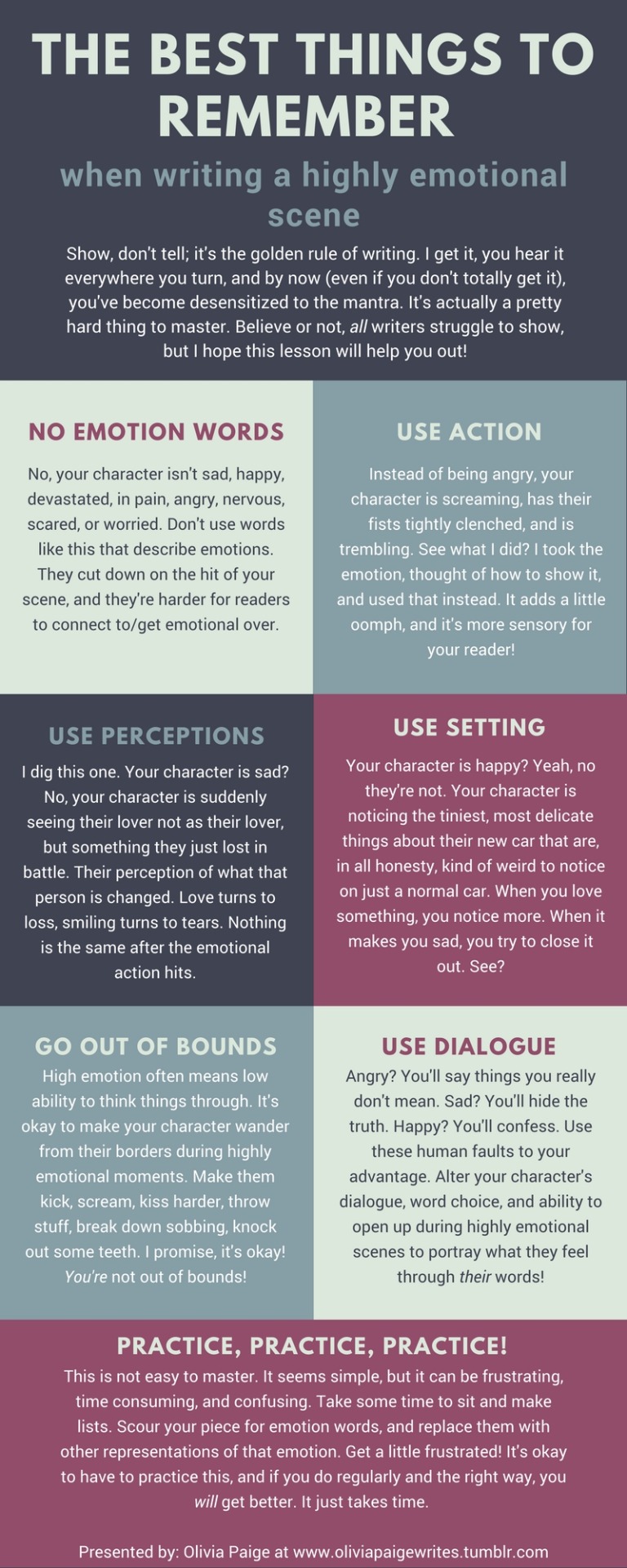
THIS IS AN IMPORTANT ONE! Don’t ignore this in your writing!
Writing Character Relationships
Character relationships are important to add dimension to the characters and can help make them and the plot more realistic. This isn’t just for romantic relationships because building the characters’ platonic and familial relationships are important as well. So here are a few tips on creating believable and endearing relationships your readers will love.
Don’t rush into it. This goes for platonic relationships as well as romantic ones. A big cliché complaint with romance stories is that the two characters tend to meet and fall head over heels in love with each other after two conversations or one loving glance across the room (sorry Romeo and Juliet). While romantic connections can begin on the first date, the characters probably shouldn’t be professing undying love and devotion to each other an hour after meeting. The problem isn’t so much the length of time that they’ve known each other as it is how well they know each other, which is why character friendships need time too. If your characters spend two full days together where they really get to know each other deeply and we can see the progression from strangers to people who understand each other, great. If their relationship spans a year but all they do is check each other out then you have a problem. Make them know each other and interact in meaningful ways to create the relationship and show how it came to be.
Show their history. Not every relationship your characters have is going to be created in the span of time in which the story takes place. Your character might have a best friend they’ve known for ten years or three older siblings. Just because these predate the beginning of the story doesn’t mean you don’t have to show what kind of relationship they have. You can say that so-and-so is the best friend but you have to make us believe it. Are they the kind of friends that tell each other everything, like even what they probably shouldn’t? Or are they more the kind that have fun and leave the drama when they go out? Show what kind of relationship the characters have rather than just telling.
Give the reader a sense of why the relationship fits. In some stories you read about the guy and the girl who are just so cute together and they’re falling in love but…why? Why does this pairing work? Having things in common is important, particularly in things that are important to the character, like values. But they can and should also have differences, some of which serve to make the other better. Together they should push each other and support each other. If you make them connect in this way it makes the connection much stronger to the reader and that makes them want to cheer them on more. If it’s all about the smooching it can get rather boring quite quickly.
Make them complete without the other(s). I know I just said that making the characters push each other is a good thing, but they still need to be complete characters on their own. If the only real thing you can say about the character is that they are X’s soulmate or best friend, then they’re not a character. It’s more interesting to see how people interact with each other than Love Interests™ following each other around.
Writing Character Arcs
Post suggested by @amethystvalkyrie.
Let’s get this out straight away: You cannot disregard character arcs. The way you can think of character arcs is that readers usually come for the plot but stay for the character because you can have a kick ass plot but if the characters don’t have depth and don’t grow or change throughout, then the readers can’t connect to the story. Readers need to care about the character to care about what they are going through and the best way to do this is through their arc. Now, though attention to character is always important, certain genres demand more than others just like certain genres demand more plot than others. For example, literary, contemporary YA, and romance put more emphasis of character than more plot-driven genres like thriller, adventure, fantasy and sci fi. In any case, character arc enhances the story but it can be tricky to understand how create this arc and how to use it to better the story, so here are some tips:
Really, think of it as a curve. Okay, so maybe not a nice smooth curve, more like one with a bunch of bumps and squiggles in it. Also, the direction of this curve depends on who you want your character to become. Usually, a protagonist will arc up, starting at point where they have some personal obstacles to overcome, whether this is just a few things or a major attitude adjustment. You can also have characters that arc down and progressively get worse, like a villain or a tragic hero. The point is that as the time goes on, your characters should move on the Y axis (sorry for the math). You can actually plot it out if it helps you understand the rises and falls of your character’s arc.
Find what each character really needs to change. What is holding them back from achieving their goal? Why is it so important that they change? What would happen or who would they be if they don’t change? Alternatively, what can go wrong if they change or change for the worse? Remember that not every character arc is a positive one and sometimes readers need to see the characters fall to understand what is at stake and cheer for them more when they get back up.
Don’t make it sudden or pointless. Like anything else in your story you want to make the character’s advancement (or deterioration) have a cause and effect relationship. Something that happens in the story causes the character to have to change or at least consider how their actions are impacting others and their own life. A drunk who gets into a car accident and nearly kills their kid. A hero whose selfishness nearly causes the destruction of a village. Typically, the biggest shifts happen near the climax where the stakes are highest and the character has to make the biggest decisions.
Don’t make the character passive. Passive characters, in particular passive protagonists are unbearable. These are the ones that have the plot happen to them rather than contributing to the direction and outcome of the events. A character needs to take charge of their own destiny even if it’s a story where destiny is literally coming after them. Like I said before, some genres have more room for this than others. A high-stakes thriller that’s more plot driven has moments where the characters have to struggle to keep up with the events happening to them, but they should still be making the major decisions that ultimately lead to the conclusion. When the characters aren’t being decisive they can’t grow or change and their personal story stays flat and boring.
On Describing Characters

Anonymous asked: “I’ve been writing in first person for my novel, but I’ve found I’m not sure how to describe the main character’s appearance.”
First person in particular can be a bit of a challenge when it comes to describing appearances. I think all the way around the trick of describing the way they look while looking into a mirror is a little tired and often hard to make it feel believable. The method I find most helpful is describing by comparison.
Keep reading
Writing Antagonists: (Aka, Your Villains and Bad Guys)
The antagonist is often either one of the most fun things to write, or the most dreaded. But either way, they are a key element of the story, and that cannot be ignored. So, let’s talk about how to make a really great antagonist.
You may have in the past met a writer or teacher or whomever who insists on using the words “protagonist and antagonist” over words like “hero and villain.” Personally, I am not so stingy about it, I feel that I know what you mean anyway so it doesn’t really matter- what there is a legitimate reason as to why you should at least try to think of your villain as your antagonist instead.
And that reason is connotation. Well, denotation too, really- villain and antagonist aren’t completely the same thing, but I’m bringing it down to connotation.
Simply said, when you think of the word “villain”, you’ll think something like “that’s the bad guy in the story.” And when you think of the “antagonist”, you probably think “that’s a fancy word for villain, aka the bad guy in the story.”
But antagonist isn’t just a fancy word. It’s a fancy concept. It means “the guy that opposes the good guy.” That can be on any argument or view. When writing your antagonist is to remember that nothing is black/white, good/bad thinking, and that includes your antagonist.
Let’s map out the steps to making a complex villain- aka, an antagonist.
First, remember that your antagonist (usually) is a person, just like your protagonist. It might help to develop them outside of their intentions first, and put a person to the upcoming reputation.
Background:
Chances are, your antagonist didn’t just rise up out of the ground ready to kill. They came from somewhere. Your readers don’t even have to know everything about your antag’s backstory, but you do, if you want to really understand them. It often holds the key reason as to why your antagonist is where they are. The drive behind anger, revenge, change, or pleasing someone else can come from the events in their background.
Why do they hold the beliefs they hold? Were they raised that way? Were they taught by some mentor figure? Were they cover from a reality they couldn’t bear? Are they trying to please someone, or get revenge on someone who displeased them? The answer should be in their background.
Motives/Beliefs:
Remember, every villain is a hero in their own mind. They believe that what they are doing is necessary, even if they recognize that it is unpleasant. What are they fighting for? Why does it matter to them so much, that they are willing to overlook all the harm they do?
“The Greater Good”: This is one of the more common and understandable villain motives. They believe that what they are doing now is paving the way to a better future. But keep in mind that what your antag views as a “better future” may be very, very different than the average opinion. Maybe a “better future” for them is a genocidal purge or the world ending in flames. Who knows.
That’s not the only type of motive. Be creative. Work with the information you established in your character’s background to find the most reasonable motive.
Tipping Point:
This is going to be related to your background and motive in an interesting way. Think of your antagonist as a character who has already completed their Character Arc and reached a negative end. Look at the points of change on the character arc- the ones that push your character farther down their path. What are those events? Those are the tipping points that prompted your character towards becoming they way they are now- those key moments where your character had a choice, and they chose to become bitter, hateful, vengeful, cold, or other negative things.
These could be the deaths of loved ones, the promptings of a mentor, or a moment of injustice that made them realize that the world isn’t always kind.
Personality/Actions:
This is the part where you develop them outside of their intentions. How do they behave?
It’s tempting to just say that your villain is a villain because they torture and kill people. But those are not the only things that make a villain a scary or serious threat. Some characters might jump to violence easier than others. Some might be more into psychological torment. Some might actually seem really charming or persuasive, which is frightening in it’s own way- they might actually be tricky enough to confuse you into making bad decisions on your own. Think about your character’s background again. What makes the most sense for them as a person?
Presentation:
This is how your antagonist comes across to others. Keep in mind that your reader and your other characters don’t know your antagonist like you do. How does this person present to the world?
-Are they open to discussion/negotiation?
-Are they open about their intentions?
-How quick are they to violence?
-What are their methods of war?
-When you meet them, are they charismatic, quiet, charming, vulgar? Do they have a sense of humor, or are they stoic?
-Do they seem to enjoy what they are doing, or do they express regrets even as they do it?
Moral Complexity:
What are they willing to do to achieve their goals? Do they have weaknesses in their personal lives?
1. Do they have noble ends behind their controversial means?
2. Is there a line even they won’t cross?
3. Do they have someone/something that they care about?
4. Do they prefer to do the killing/torturing etc themselves or do they just give the order?
Remember that if your antagonist does have any of these moral weaknesses, they are not going to want to show it. One has to keep up intimidating appearances, after all.
Speaking of appearances…
Appearance:
This part is here to tell you what not to do. There are certain appearances that are getting really old with villains.
1. Dressing in all black. Why do they even do that? It’s time to stop associating black with “bad” and white with “good”. It just isn’t like that, so stop making villains all dark and stuff.
2. Scars. I think scars are pretty cool, don’t get me wrong. But if there is no relevant reason for it to be there, don’t talk about it all the time. That goes for all characters, not just villains. Like the color black, scars are not just a villain thing. Everyone has them. Don’t associate them with “bad.”
3. Sexy. I get the idea that making a villain attractive makes them harder to hate, but that can be kind of a cop out of actual complexity. Again, if there is no legitimate reason to make your villain sexy, then don’t. It’s not necessary.
4. Ugly. I hesitate to call any traits inherently ugly, but if you’re striving to make your character unpleasant looking just because they’re bad, then once again, you are associating feature=evil, which is not creative at best and seriously socially harmful at worst.
Basically, your villains should be just as diverse as anyone else. You don’t need stereotypes to make them scary. Sometimes it’s scarier than anything else to just have an average person. It sort of adds to the idea that anyone could be a villain. And that’s pretty frightening.
Key Point:
- Complicate your villains. They’re not just Evil McEvilpants.
That’s it for now, but like anything else in writing, antagonists have a lot of possibility and exceptions. But that was your basic rundown on the things to consider when making a complicated antagonist.
~Penemue
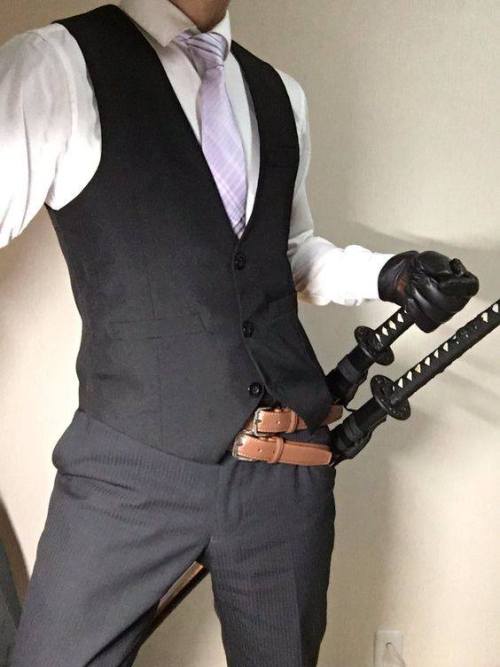
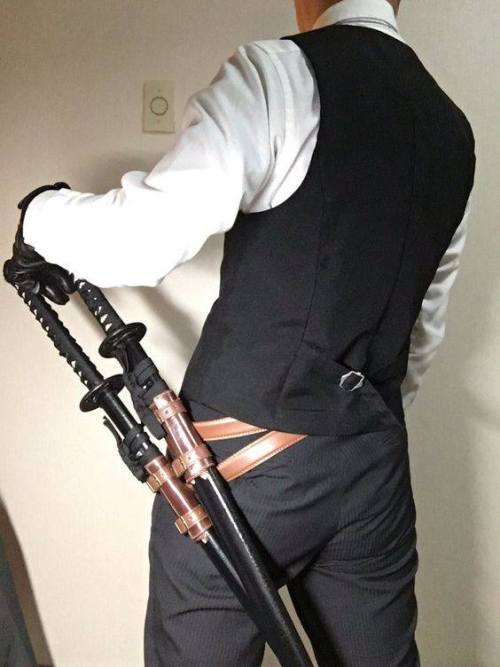
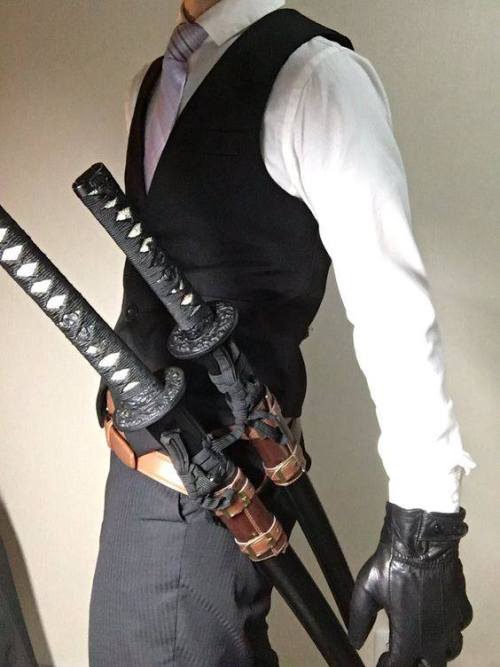
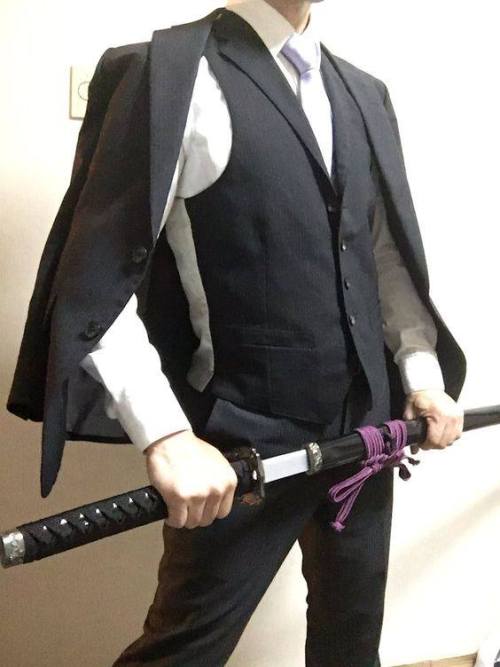
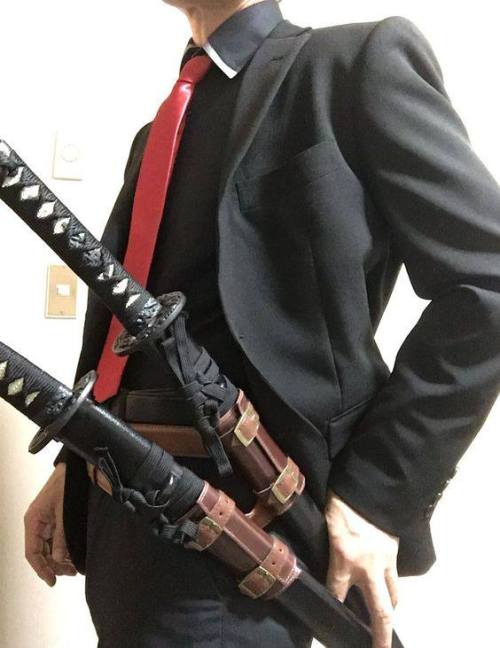
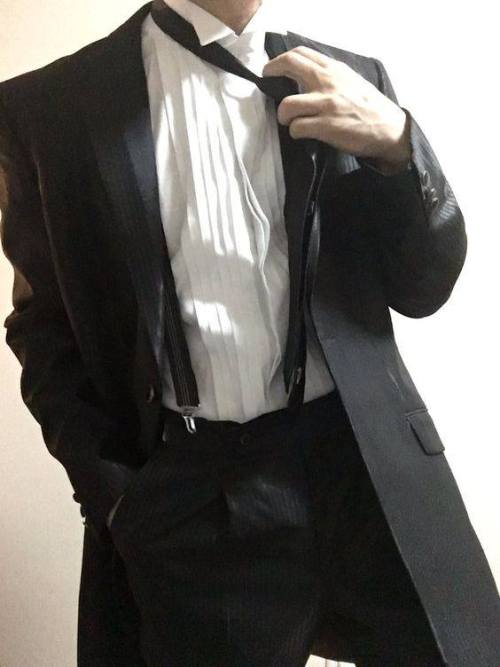
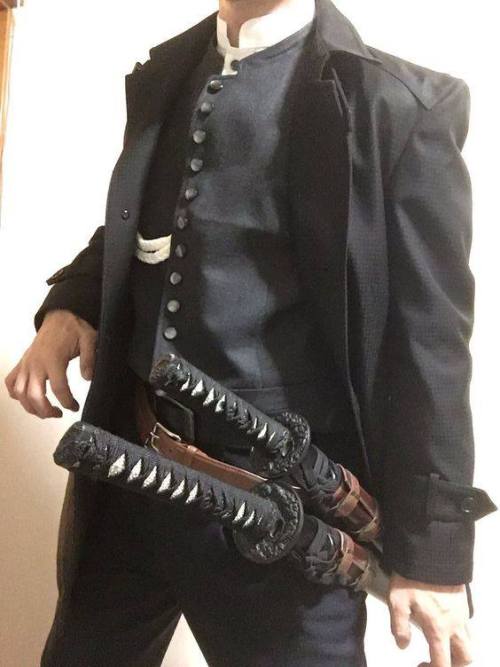
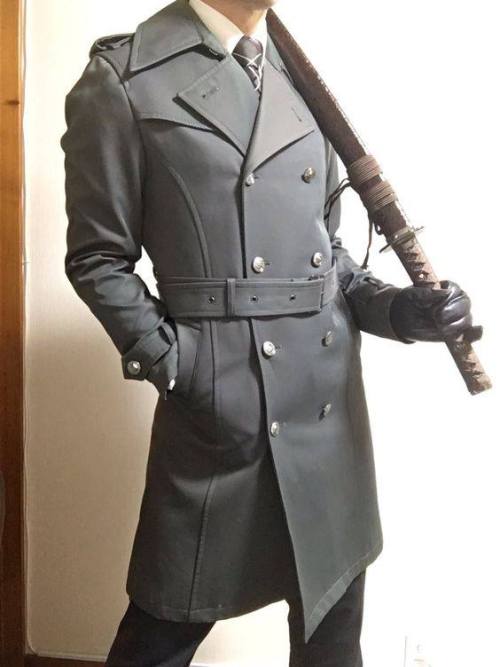

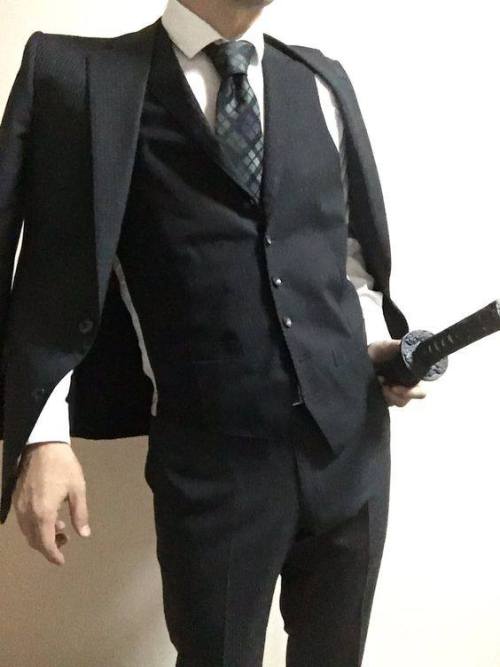
Can you do puppy stony
I fanlly complete it!


I’m very very very like Pomeranian much!
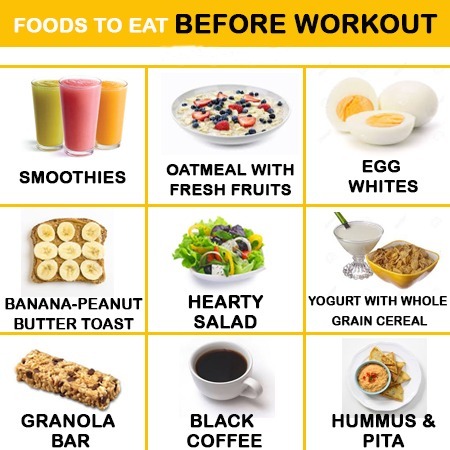
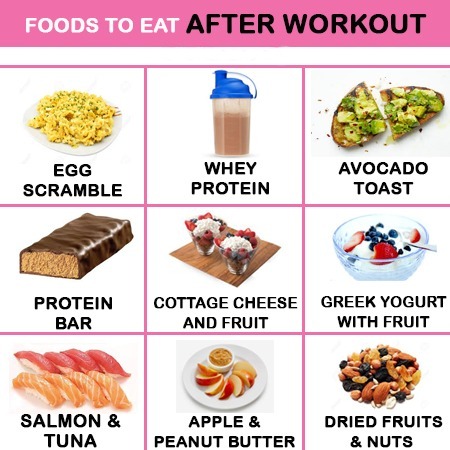
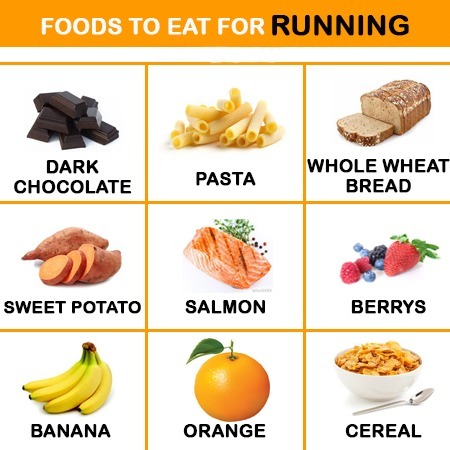





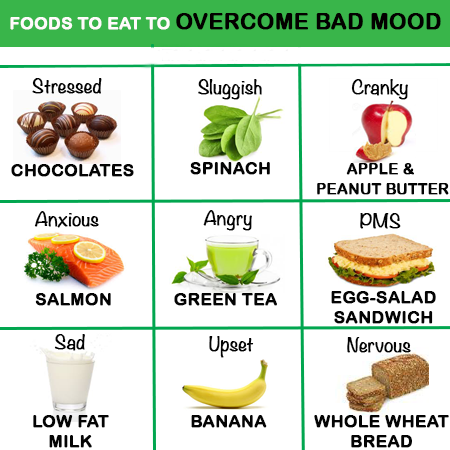




Virtue requires a delicate balance.
Knuckle: Daemon, did you know that Jesus loves you?
Daemon, turning to Giotto: Oi, Giotto!
Giotto: What.
Daemon: Do you love me, bro?
Giotto: No, I hate you.
Daemon: *leaves the Vongola*
Xanxus: Tell him about the birds and the bees.
Squalo, to Bel: They're disappearing at an alarming rate.

VICTORIAN TEA CAKE!
½ cup unsalted butter softened 1 cup granulated sugar 2 eggs at room temperature ½ teaspoon vanilla 1 ¾ cup sifted cake-and-pastry flour 1 ½ teaspoon baking powder 1 pinch salt ½ cup milk icing sugar
Filling : 2/3 cups whipping cream ½ cup strawberry jam
Grease and flour 8- or 9-inch (1.2 or 1.5 L) round metal cake pan; line bottom with parchment paper. Set aside.
In large bowl, beat butter until light and pale, about 2 minutes. Beat in sugar, 3 tbsp (45 mL) at a time, beating for 30 seconds after each addition, about 2 minutes. Beat in eggs, 1 at a time, beating well after each. Beat in vanilla.
In separate bowl, whisk together flour, baking powder and salt; sift into butter mixture alternately with milk, making 3 additions of dry ingredients and 2 of milk. Scrape into prepared pan.
Bake in 350 F (180 C) oven until cake tester inserted in centre comes out clean, 30 to 35 minutes. Let cool in pan on rack for 10 minutes. Turn out onto rack; peel off paper. Let cool.
Filling: In bowl, whip cream. Invert cake onto platter. Using long serrated knife, cut in half horizontally. Spread with jam; top with cream. Replace top of cake. Sift icing sugar over top.









The memories I have for some of these shows disturb me
Do you ever get that sudden outburst of motivation to go and make your life better then after 5 mins you’re like yeah that’s not happening
A Somewhat Useful Masterpost for Writers
Websites:
Write or Die is great if you want to give yourself a certain amount of time to write a set amount of words.
Tip of my Tongue for when you can’t remember the exact word
Character Traits Form
Online Thesaurus where you just type in a word and you get a cluster of different words
Characters
Top 10 Questions for Creating Believable Characters
How to Create a Fictional Character
Describing Clothing and Appearance
The Difference between Ethnicity and Nationality
Describing a Voice
Characters (part 2)
How to write Funeral Directors I’ve read quite a few fanfics where they just have funeral directors slapping clothes on a body and calling it a day. As a former funeral services major I can tell you that’s not the only thing they do.
How to write Drug Dealers
How to write Gamblers
Interview with a Hitman
Terms for royalty
Naming Characters
Behind the Name
Top Baby Names
Looking for a name that means a certain thing?
7 Rules of Picking Names
Most Common Surnames
Medical/Crime/Legal
Coma: Types, Causes, etc
Tips for writing blood loss
Gunshot Wound Care
Examples of Hospital Forms
Common Legal Questions
The Writer’s Forensics Blog
Brain Injury Legal Guide
Types of Surgical Operations
Types of Mental Health Problems
A Day in the Life of a Mental Hospital Patient
Global Black Market Information Because where else would you find out how much money it takes to get a 16 year old girl to kill someone in Mexico?
Crime Scene Science
Examining Mob Mentality
How Street Gangs Work
Other Helpful Stuff
Poisonous Herbs and Plants
The Psychology of Color
The Meaning behind Rose color
Compare Character Heights - I personally love this site so much.
Types of Swords
Color Symbolism
How a handgun works
Blueprints for Houses
The Six Types of Haunting Activities
The Difference Between lay and lie
10 Words You Need to Stop Misspelling
5 Easy Tips to Improve Your Writing
How to Write a Eulogy
Types of Crying
Career Masterpost
Avoiding LGBTQ Stereotypes
Tips for Writing Ghost Stories
A Spell to See Spirits
Make Graphics out of Quotes
Superstitions and More
The 12 Common Archetypes
Language of Flowers
Military Sign Language
A Visual Dictionary of Tops
Describing Tiaras
What author do you most write like? (I’ve gotten Stephenie Meyer)
12 Realistic Woman Body Shapes
Japanese honorifics
Articles
25 Steps To Edit the Unmerciful Suck out of Your Story
10 Rules for Writing First Drafts
10 Things Teenage Writers Should Know About Writing
Create a Plot Outline in 8 Easy Steps
Publishing Agencies to Stay Away From
5 Ways to Make Your Novel Helplessly Addictive
Read More

(I feel like there’s no way this hasn’t been done before, but I couldn’t find anything, so here)
How to Plot A Complex Novel in One Day (It WILL take all day)
Now first, I have to say, that the plot you’re able to come up with in one day is not going to be without its flaws, but coming up with it all at once, the entire story unfolds right in front of you and makes you want to keep going with it. So, where to begin?
What is your premise and basic plot? Pick your plot. I recommend just pulling one from this list. No plots are “original” so making yours interesting and complicated will easily distract from that fact, that and interesting characters. Characters will be something for you to work on another day, because this is plotting day. You’ll want the main plot to be fairly straight forward, because a confusing main plot will doom you if you want subplots.
Decide who the characters will be. They don’t have to have names at this point. You don’t even need to know who they are other than why they have to be in the story. The more characters there are the more complicated the plot will be. If you intend to have more than one subplot, then you’ll want more characters. Multiple interconnected subplots will give the illusion that the story is very complicated and will give the reader a lot of different things to look at at all times. It also gives you the chance to develop many side characters. The plot I worked out yesterday had 13 characters, all were necessary. Decide their “roles” don’t bother with much else. This seems shallow, but this is plot. Plot is shallow.
Now, decide what drives each character. Why specifically are they in this story? You can make this up. You don’t even know these characters yet. Just so long as everyone has their own motivations, you’re in the clear.
What aren’t these characters giving away right off the bat? Give them a secret! It doesn’t have to be something that they are actively lying about or trying to hide, just find something that perhaps ties them into the plot or subplot. This is a moment to dig into subplot. This does not need to be at all connected to their drive to be present in the story. Decide who is in love with who, what did this person do in the 70’s that’s coming back to bite them today, and what continues to haunt what-his-face to this very day. This is where you start to see the characters take shape. Don’t worry much about who they are or what they look like, just focus on what they’re doing to the story.
What is going to change these characters? Now this will take some thinking. Everyone wants at least a few of the characters to come out changed by the end of the story, so think, how will they be different as a result of the plot/subplot? It might not be plot that changes them, but if you have a lot of characters, a few changes that are worked into the bones of the plot might help you.
Now list out the major events of the novel with subplot in chronological order. This will be your timeline. Especially list the historical things that you want to exist in backstory. List everything you can think of. Think about where the story is going. At this point, you likely haven’t focused too much on the main plot, yeah, it’s there, but now really focus on the rising actions, how this main plot builds its conflict, then the climactic moment. Make sure you get all of that in there. This might take a few hours.
Decide where to start writing. This part will take a LOT of thinking. It’s hard! But now that you’ve got the timeline, pick an interesting point to begin at. Something with action. Something relevant. Preferably not at the beginning of your timeline - you want to have huge reveals later on where these important things that happened prior are exposed. This is the point where you think about what information should come out when. This will be a revision of your last list, except instead of being chronological, it exists to build tension.
Once you’ve gotten the second list done, you’ve got a plot. Does it need work? Probably. But with that said, at this point you probably have no idea who half your characters are. Save that for tomorrow, that too will be a lot of work.
After you’ve plotted the loose structure of your novel from this, see my next post to work on character!



One of the most important scenes in anime history






Ciel naming Sebastian (.◜ω◝.)
**Please do not reupload here/on other sites**










Just leave me your stardust to remember you by
Underrated Anime
Here are some titles that I feel deserve more love than they get!
From the New World - This anime was a masterpiece. Paced and well-planned, the show entangles you without you knowing until its too late. I highly recommend it for anyone who wants to sink their teeth into a psychological fantasy that leave you with a strange mix of innocence and uneasiness.

Princess Jellyfish - A love story between a confident and fashionable crossdresser and an awkward, introverted girl. This is golden!

Welcome to the NKH! - Just the right amount of humor and psychological torment to keep every viewer enthralled. Is it a conspiracy?

Monster - What happens when a promising young doctor saves the life of a boy who was fated to die? A gripping thriller of justice and revenge!
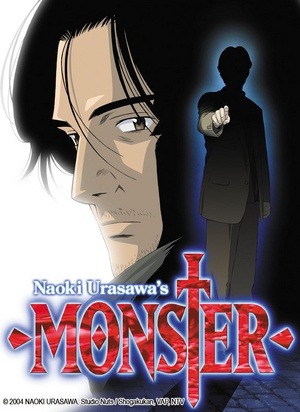
Bokurano - A group of kids become the chosen pilots of a robot faced with saving the planet, a beyond awesome experience for them!…or so they think. They sign the binding contract and now each one of them must pay the price.

Wolf’s Rain - As legend has it, wolves will open the gate to Paradise in a dying world. This anime is a gripping, heart-wrenching tale of an unlikely pack of wolves searching for promised Paradise. Out of any of the shows on this list, Wolf’s Rain is worth watching. It is a legend it its own right.

Samurai Champloo - THE MUSIC. The music alone should be enough to draw you into this epic tale, but in case you need more persuasion, know that this show revolves around the two most badass fighters in town and their quest to help a girl they are indebted to find the samurai who smells of sunflowers. Ugh its so gooooood.

Mawaru Penguindrum - Weird and comical sum up this anime pretty nicely! It is a fun watch that you will find hard not to binge on once you start. Stay with me people: An alien penguin-hat grants a girl her life back in exchange for her two bothers’ help in acquiring the Penguindrum (whatever that is). I know what you are thinking, but please give it a try! You won’t regret it!

Eden of the East - “This nation faces a great crisis. One among you must save us. I cannot tell you how. I cannot tell you why. Should you fail, you will be eliminated.” 12 people have been chosen to save Japan, each given a phone with 10 billion yen on it and the simple instruction to save Japan–their lives are on the line. Despite this harsh description, the actual show also has an element of humor, so don’t be afraid to jump in! Noblesse Oblige.

Steins;Gate - Many of you have probably heard of this and thought that is was too stuffy or complicated for you, but I’m here to tell you that you will watch this show, make it to episode 22, and then thank me. YOUR WELCOME. Sure, this show takes some getting into, but once you delve deeper into the plot, you will find things falling into place. It has unconventional characters, a really great romance stuck in there, and a pretty refreshing, sciency tone. Enjoy.

Nodame Cantabile - To think that so many people have not seen this gift to humanity sickens me. Nodame is most assuredly the most interesting and unique anime character to walk this little anime earth. There is music! There is romance! There is SO MUCH HUMOR! There are 3 seasons!!! You can’t really pass up this opportunity to watch a legend.

Hunter X Hunter (2011) - This is the only long-running shonen series I will ever watch. This is a series for those of you who like action but not fight scenes that span multiple episodes and like actual character development and good animation consistently throughout the show (I swear its perfect the whole way). Gon wants to be a Hunter just like his father and he meets Killua, the boy-assassin (an resident cinnamon roll), Kurapika, the last of the Kurta clan hell-bent on revenge, and Leorio, a guy who wants to strike it rich. Follow these four on a journey you won’t forget!


“Have we met before?”
“No…no.”
“Then why are you crying?”
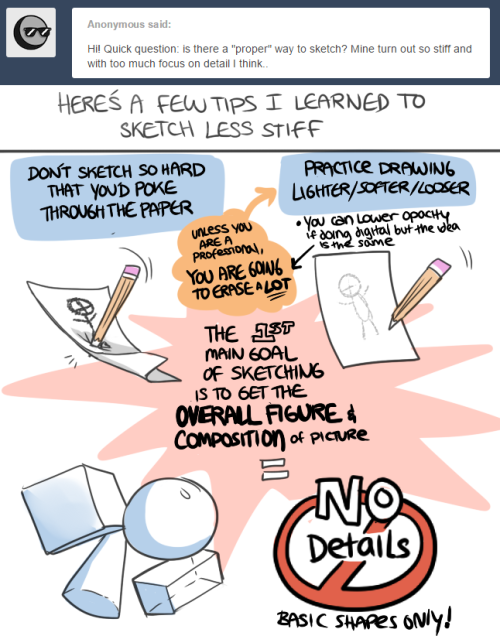



Sketching Tips
How can I get faster at drawing? I want to start a comic series but I take too long to draw the strips.
Hi anon! This is a great question!
I would recommend not getting hung up during the sketching process. Sketching quickly without over editing will speed up your workflow a lot, and allow your work to flow more easily.
Practicing quick gesture drawing and composition thumbnails will be especially helpful for you, and hopefully help you gain both speed and confidence. Also study storyboarding concepts, as that might help you draw strips more quickly. A ruler might be helpful if going traditional, and digital will allow for faster and easier edits to strips.
Further Reading/Other Resources
How to Draw Faster - video
Speed Comicking – Artist Advice – Medium
Draw more Accurately - helpful because consistency in comics is good
Resources for Comickers
Hope this helped! Please consider giving this post a reblog/like if you enjoyed it! It helps @art-res reach more people!
More Helpful links: Ask a Question/Request a Tut |Submit a Tutorial | Promote Your Art Commissions to +15 K Dashes | Support my art on DeviantArt / Tumblr ( @astrikos )
Hi! I want to draw people with a lot of emotion captured, but I don't really know how to do it so that the viewer feels something. I want to show more emotion, I guess? (This was really unclear, I know :0) Thank you so much!
What a great question, @everchangingotps!
I think studying anatomy helps a lot. Facial muscles are a bit complex, and they move in different ways to make the frowns and smiles happen!
Here’s a few great resources I found:
Human Anatomy Fundamentals, Mastering facial Expressions - super comprehensive. Definitely worth the read!
Muscles of Facial Expression - Anatomyzone
Drawing facial expressions - Xia Taptara on Youtube
Folder of Facial Expression Tutorials! Super useful
Expression tutorial by shingworks - cartoon style
If you liked this post, please consider reblogging this post so more artists can see it!
Also it would mean the world to me if you checked out my art at @astrikos!
Thank you for your continued support!



My worst fear on a test? The feeling of getting an exam paper in front of me, and not being able to remember anything, while back at home when reading the book I thought I knew everything. Sounds familiar? In that case, it may help to try these techniques. They help you practice retrieving information, rather than being familiar with the concepts you are studying. These have helped me loads, and I’m actually pretty convinced that these techniques are better than many others I used to apply, like rereading and regular summarizing. Hopefully they work for others as well :)
1. Summarise… in questions.
How do you do it? Instead of writing down facts, you convert facts to questions. Underneath the these, you answer them in your own words. This is technically the baby of summaries and flashcards. Don’t do this with every small fact, but rather convert several to one question, and omit the less important things always. You’re not going to remember every detail and most teachers don’t require you to (of course if they do, study them lol) .
Why would you do it? It is proven that asking yourself questions about the material enhances understanding and remembrance. Additionally, you can instantly quiz yourself on the material. Only reading your summary is not going to help you much with remembering, but actively retrieving information is! Also, when you’re reading and summarising the textbook throughout the semester, you’re already getting your study material for the test ready => less stress and work for when you gotta study.
2. Teach your peer / pet / pillow
How do you do it? Explain key concepts (many books provide these at the beginning or end of the chapter) to anyone who wants to listen. Don’t have anyone who wants to? Your cat probably won’t mind (but who knows what cats want tbh) and your reflection is always listening to you as well.
Why would you do it? Explaining things to other people requires you to really understand what you are talking about, and you will more quickly find holes in your knowledge once you’re not able to explain it. Additionally, you’re probably gonna have to explain stuff on tests so it’s good practice.
3. Re-do your homework
How do you do it? Pretty obvious. Well, don’t write every answer down in detail again! For maths it may be useful to only tackle the most important exercises again, while for history you may want to spend an hour to just go over them all and test in your head if you can form a sensible answer.
Why would you do it? Going over the homework is always a good idea because 1) the theory is practically applied in those questions, so you have to think about what you have learned, enhancing integration, and 2) teachers are lazy and will often reuse or slightly modify textbook questions.